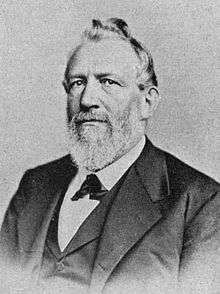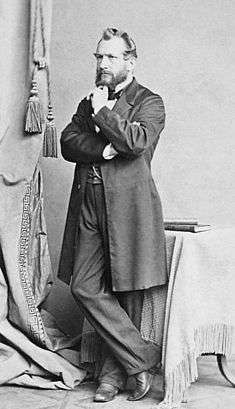Emil du Bois-Reymond
Emil Heinrich du Bois-Reymond (7 November 1818 – 26 December 1896) was a German physician and physiologist, the co-discoverer of nerve action potential, and the developer of experimental electrophysiology.
Emil du Bois-Reymond | |
|---|---|
 | |
| Born | 7 November 1818 |
| Died | 26 December 1896 (aged 78) Berlin, Germany |
| Nationality | German |
| Alma mater | University of Berlin |
| Known for | Nerve action potential |
| Spouse(s) | Jeannette du Bois-Reymond, née Claude |
| Children | 9 |
| Scientific career | |
| Fields | |
| Doctoral advisor | Johannes Müller |
| Other academic advisors | Karl Bogislaus Reichert, Heinrich Wilhelm Dove, Gustav Magnus |
| Notable students | William James |
| Influences | Lucretius, Comte |
| Influenced | Eduard Hitzig, Julius Bernstein |
Life
Du Bois-Reymond was born in Berlin and spent his working life there. One of his younger brothers was the mathematician Paul du Bois-Reymond (1831–1889). His father was from Neuchâtel, and his mother was a Berliner of Huguenot origin.[1][2]
Educated first at the French College in Berlin, du Bois-Reymond enrolled in the University of Berlin in 1838. He seems to have been uncertain at first as to the topic of his studies, for he was a student of the renowned ecclesiastical historian August Neander, and dallied with geology and physics, but eventually began to study medicine with such zeal and success as to attract the notice of Johannes Peter Müller (1801–1858), a well-known professor of anatomy and physiology.[1]
Müller's earlier studies had been distinctly physiological, but his preferences caused him later to study comparative anatomy. He had, about the time when the young du Bois-Reymond came to his lectures, published his Elements of Physiology, in which the following statement occurs:[3]
"Though there appears to be something in the phenomena of living beings which cannot be explained by ordinary mechanical, physical or chemical laws, much may be so explained, and we may without fear push these explanations as far as we can, so long as we keep to the solid ground of observation and experiment."
During 1840 Müller made du Bois-Reymond his assistant in physiology, and as the beginning of an inquiry gave him a copy of the essay which the Italian Carlo Matteucci had just published on the electric phenomena of animals.[4][5] This determined the work of du Bois-Reymond's life. He chose as the subject of his graduation thesis Electric fishes, and so commenced a long series of investigations on bioelectricity. The results of these inquiries were made known partly in papers communicated to scientific journals, but also and chiefly by his work Investigations of Animal Electricity, the first part of which was published in 1848, the last in 1884.[3]
Concerning his religious opinions, du Bois-Reymond was an atheist or at best agnostic.[6]
Works

Investigations of Animal Electricity may be seen in two ways. On the one hand, it is a record of the exact determination and approximative analysis of the electric phenomena presented by living beings. Viewed from this standpoint, it represents a significant advance in biological knowledge. Du Bois-Reymond built up this branch of science, by inventing or improving methods, by devising new instruments of observation, or by adapting old ones. On the other hand, the volumes in question contain an exposition of a theory of bioelectricity. In them Du Bois-Reymond put forward a general conception that a living tissue, such as muscle, might be regarded as composed of a number of electric molecules, and that the electric behavior of the muscle was the product of these elementary units.[3] We now know that these are sodium, potassium and other ions, the gradients of which are responsible for maintaining membrane potentials in excitable cells.
His theory was soon criticized by several contemporary physiologists, such as Ludimar Hermann, who maintained that intact living tissue, such as muscle, does not generate electric currents unless it has suffered injury.[7] The subsequent controversy was ultimately resolved in 1902 by du Bois-Reymond's student Julius Bernstein, who incorporated parts of both theories into an ionic model of action potential.[8][9] Thus, du Bois-Reymond's work mainly concerned animal electricity, although he made other physiological inquiries — such as could be studied by physical methods — concerning the phenomena of diffusion, the muscular production of lactic acid, and the development of shocks by electric fishes.
Du Bois-Reymond exerted great influence as a teacher.[10] In 1858, upon the death of Johannes Müller, the professorship of anatomy and physiology at the University of Berlin was divided into a professorship of human and comparative anatomy, which was given to Karl Bogislaus Reichert (1811–1883), and a professorship of physiology, which was given to du Bois-Reymond. This he held until his death, performing research for many years without adequate accommodation. In 1877, the Prussian government granted his wish and provided the university with a modern physiological laboratory.
In 1851 he was admitted to the Academy of Sciences of Berlin, and in 1876 he became its perpetual secretary.[3] Like his friend Hermann von Helmholtz, who had also studied under Johannes Peter Müller, du Bois-Reymond was known throughout Germany. He used his influence for the advancement of science, introducing the theories of thermodynamics and Darwin to students at the University of Berlin.[3][11] He owed the largest part of his fame, however, to occasional discourses on literature, history, and philosophy.
The Seven World Riddles
In 1880 du Bois-Reymond delivered a speech to the Berlin Academy of Sciences enumerating seven "world riddles" or "shortcomings" of science:[12]
- the ultimate nature of matter and force;
- the origin of motion;
- the origin of life;
- the "apparently teleological arrangements of nature" (not an "absolutely transcendent riddle");
- the origin of simple sensations ("a quite transcendent" question);
- the origin of intelligent thought and language (which might be known if the origin of sensations could be known); and
- the question of free will.[13]
Concerning numbers 1, 2 and 5 he proclaimed "Ignorabimus" ("we will never know"). Concerning number 7 he proclaimed "Dubitemus" ("we doubt it').
References
- Chisholm 1911, p. 625.
- Finkelstein, Gabriel (2013). Emil du Bois-Reymond: neuroscience, self, and society in nineteenth-century Germany. Cambridge, Massachusetts; London, England: The MIT Press. pp. 3–13. ISBN 978-1-4619-5032-5. OCLC 864592470.
- Chisholm 1911, p. 626.
- Clarke, Edwin; Jacyna, L. S. (1987). Nineteenth-century origins of neuroscientific concepts. Berkeley: University of California Press. pp. 157–211. ISBN 0-520-05694-9. OCLC 13456516.
- Finkelstein, Gabriel (2006). "Matteucci and du Bois-Reymond: A Bitter Rivalry". Archives italiennes de biologie: A journal of neuroscience. 149 (4): 29–37.
- Meulders, Michel (2010). "5: Helmholtz and the Understanding of Nature". Helmholtz: From Enlightenment to Neuroscience. Translated by Garey, Laurence. Cambridge, Massachusetts; London, England: The MIT Press. p. 74. ISBN 9780262014489.
Du Bois-Reymond was a self-proclaimed atheist but more through intimate conviction than logical necessity.
- Finkelstein, Gabriel (1 May 2006). "Emil du Bois-Reymond vs Ludimar Hermann". Comptes Rendus Biologies. Aspects de l'histoire des neurosciences. 329 (5): 340–347. doi:10.1016/j.crvi.2006.03.005. ISSN 1631-0691.
- Seyfarth, Ernst-August (January 2006). "Julius Bernstein (1839–1917): pioneer neurobiologist and biophysicist". Biological Cybernetics. 94 (1): 2–8. doi:10.1007/s00422-005-0031-y. ISSN 0340-1200.
- De Palma, Armando; Pareti, Germana (October 2011). "Bernstein's Long Path to Membrane Theory: Radical Change and Conservation in Nineteenth-Century German Electrophysiology". Journal of the History of the Neurosciences. 20 (4): 306–337. doi:10.1080/0964704X.2010.532024. ISSN 0964-704X.
- Finkelstein, Gabriel (2013). Emil du Bois-Reymond: neuroscience, self, and society in nineteenth-century Germany. Cambridge, Massachusetts; London, England: The MIT Press. pp. 174–179. ISBN 978-1-4619-5032-5. OCLC 864592470.
- Finkelstein, Gabriel (2019). "Haeckel and du Bois-Reymond: rival German Darwinists". Theory in Biosciences. 138 (1): 105–112. doi:10.1007/s12064-019-00282-6. ISSN 1431-7613.
- Finkelstein, Gabriel (2013). Emil du Bois-Reymond: neuroscience, self, and society in nineteenth-century Germany. Cambridge, Massachusetts; London, England: The MIT Press. pp. 272–273. ISBN 978-1-4619-5032-5. OCLC 864592470.
- Leverette Jr., William E. (1965). "E. L. Youmans' Crusade for Scientific Autonomy and Respectability". American Quarterly. 17 (1): 21. doi:10.2307/2711334. JSTOR 2711334.
Sources

- Cranefield, Paul F. (1 October 1957). "The Organic Physics of 1847 and the Biophysics of Today". Journal of the History of Medicine and Allied Sciences. XII (10): 407–423. doi:10.1093/jhmas/XII.10.407. ISSN 0022-5045.
- Lenoir, Timothy (1 January 1986). "Models and Instruments in the Development of Electrophysiology, 1845-1912". Historical Studies in the Physical and Biological Sciences. 17 (1): 1–54. doi:10.2307/27757574. ISSN 0890-9997.
- Naturwissen und Erkenntnis im 19. Jahrhundert : Emil Du Bois-Reymond. Mann, Gunter, ed. Akademie der Wissenschaften und der Literatur. Kommission für Geschichte der Medizin und der Naturwissenschaften. Hildesheim: Gerstenberg, 1981. ISBN 3-8067-0866-5. OCLC 8307620.
- Pearce, J M (November 2001). "Emil Heinrich Du Bois-Reymond (1818–96)". J. Neurol. Neurosurg. Psychiatry. 71 (5): 620. doi:10.1136/jnnp.71.5.620. PMC 1737619. PMID 11606673.
- Dierig, S (April 2000). "Urbanization, place of experiment and how the electric fish was caught by Emil du Bois-Reymond". Journal of the History of the Neurosciences. 9 (1): 5–13. doi:10.1076/0964-704X(200004)9:1;1-2;FT005. PMID 11232350.
- Gradmann, Christoph (2000). "Geschichte als Naturwissenschaft: Ernst Hallier und Emil du Bois-Reymond als Kulturhistoriker" [History as natural science: Ernst Hallier and Emil du Bois-Reymond as cultural historians]. Medizinhistorisches Journal (in German). 35 (1): 31–54. JSTOR 25805251. PMID 10829580.
- Meltzer, SJ (February 1897). "Emil du Bois-Reymond". Science. 5 (110): 217–219. Bibcode:1897Sci.....5..217M. doi:10.1126/science.5.110.217. PMID 17829443.
- Loos, H (August 1985). "[The relation between physiology and medicine in Emil du Bois-Reymond]". Zeitschrift für die Gesamte Hygiene und Ihre Grenzgebiete. 31 (8): 484–5. PMID 3904238.
- Geddes, L A (1999). "From muscle twitches to sustained (tetanic) contraction: the discovery of du Bois-Reymond". IEEE Engineering in Medicine and Biology Magazine. 18 (1): 85–6. PMID 9934607.
External links


- Short biography, bibliography, and links on digitized sources in the Virtual Laboratory of the Max Planck Institute for the History of Science